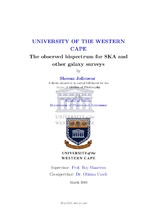The observed bispectrum for SKA and other galaxy surveys
Abstract
Next-generation galaxy surveys will usher in a new era of high precision cosmology.
They will increasingly rely on the galaxy bispectrum to provide improved constraints
on the key parameters of a cosmological model to percent level or even beyond. Hereby,
it is imperative to understand the theory of the galaxy bispectrum to at least the same
level of precision. By this, we mean to include all the general relativistic projection
effects arising from observing on the past lightcone, which still remains a theoretical
challenge. This is because unlike the galaxy power spectrum, the galaxy bispectrum
requires these lightcone corrections at second-order. For the rst time, this PhD project
looks at all the local relativistic lightcone e ects in the galaxy bispectrum for a
at
Friedmann-Lemaitre-Robertson-Walker Universe, giving full details on the second-order
scalars, vectors and tensors. These lightcone effects are mostly Doppler and gravitational
potential contributions. The vector and tensor modes are induced at second order by
scalars. We focus on the squeezed shapes for the monopole of the galaxy bispectrum
because non-Gaussianity of the local form shows high signatures for these triangular
con gurations. In the exact squeezed limit, the contributions from the vectors and
tensors vanish. These relativistic projection effects, if not included in the analysis of
observations, can be mistaken for primordial non-Gaussianity. For future surveys which
will probe equality scales and beyond, all the relativistic corrections will need to be
considered for an accurate measurement of primordial non-Gaussianity.

